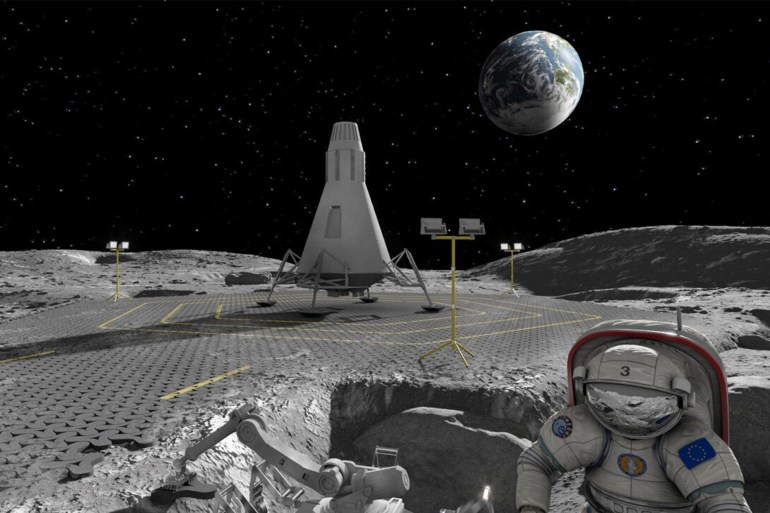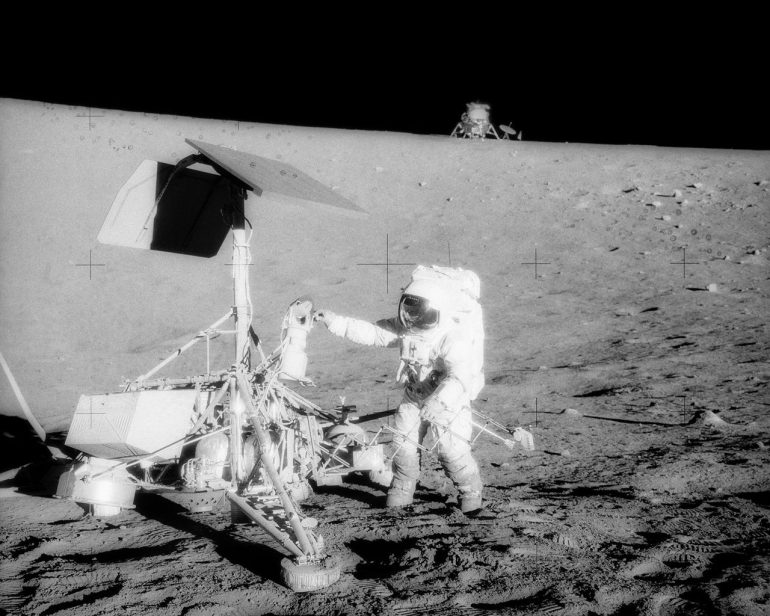385 years ago, the idea of establishing a colony on the moon was born, in 1638 the English priest, philosopher and encyclopedist John Wilkins wrote a letter about a new world and another planet, in which he predicted a human colony. in the moon.
The world is now inching closer to this dream after the US space agency set 2028 as the date to achieve it, but there are serious challenges that threaten the project, chief among them lunar dust, which is spoiled. Previous space missions, and it’s a problem posed by a research team. A German researcher found a possible solution to this problem in a study published Oct. 12 in the journal Scientific Reports, showing the possibility of using a laser to melt lunar dust. To construct paved roads and landing areas.
In a special report to Al Jazeera Net, Miranda Fateri, from the Faculty of Mechanical Engineering and Materials Science at Allen University in Germany, said: “The surface of the moon is fine, electrically charged, abrasive, and magnetically dusty, and it can stick to space suits, rovers and equipment, which presents potential challenges and risks. presents.” “
He added, “Our idea is to use dust to create paved roads, which contributes to reducing the problems associated with it, by providing a smooth and controlled surface for movement, which ultimately leads to protecting the lunar infrastructure and extending the life of the equipment.”

How did the researchers prove their point?
Lacking lunar dust that the researchers could use to prove their idea, the researchers tested microscopic material called EAC-1A, a lunar soil substitute developed by the European Space Agency, and used a 50 mm laser beam. By heating and melting the dust to about 1,600 degrees Celsius, they created curved triangular shapes, each about 25 cm wide, that interlocked to form solid surfaces over large areas of lunar soil that would serve as roads and future landing pads.
As the researchers explained in their study, this process is not easy, as each small engineering unit takes an hour to produce, which means it takes about 100 days to build a 10 x 10 meter landing pad.
To overcome the problem of the cost of transporting construction materials from Earth to the Moon, researchers were interested in how to reproduce this approach on the Moon using available resources, such as the Sun instead of laser beams.
The researchers decided that a lens with an area of about 2.37 square meters would have to be moved from the ground to act as a concentrator of sunlight instead of a laser, and that the lens could be rolled and made of polymer chips. Easy to carry.
Since dust can still be a problem when lenses accumulate, the researchers suggested that using a vibrating lens could help alleviate this problem.
Next stage of study
While it is easy for researchers to imagine problems and propose solutions to them, providing solutions on the ground is a difficult problem, and requires specialized equipment.
“The experiment was conducted in the Earth’s gravity environment,” study co-researcher Juan Carlos Genis Palomares of the Faculty of Mechanical Engineering and Materials Science at Allen University in Germany told Al Jazeera Net exclusively. If we want to bring these technologies to the Moon one day, the devices will need to be tested under conditions.” “The Moon (specifically, the absence of lunar wind and gravity), is what we will do in our next study.”
He added, “We will address manufacturing in low-gravity conditions like the Moon by taking zero-gravity travel, which will be available to anyone who wants to experience the feelings of weightlessness experienced by astronauts.”
The success of these experiments was not only in using lunar dust to pave roads on the surface of the moon, but as Palomares confirms, it can be used in more than one direction.
He says, “Moon dust can be turned into a small solid material suitable for construction in a number of ways. It can be made into bricks, it can be melted quickly to form glass, and it can also be used to make lunar cement. As researchers have done in other studies.”
A research team from the Chinese University’s Guangxi Laboratory for Petrochemical Resources Processing has succeeded in producing cement in a test environment that mimics lunar conditions, using volcanic ash similar to lunar dust. Gondwana Research in April 2017.
In the most recent experiment, a research team from the Indian Institute of Science succeeded in demonstrating the feasibility of using lunar dust to make artificial space bricks, and the results were published on the pre-research site ArXiv in August this year.

Many benefits
Regarding the economic and scientific value of building paved roads and landing pads on the Moon as part of developing lunar infrastructure for future human missions, Miranda Vatheri says, “The Moon is an ideal place to conduct scientific research and expand our understanding of the universe. , and installing telescopes and scientific instruments on its surface will provide unique and unobstructed views.” can provide.” “The constraints of space, devoid of Earth’s atmosphere, make it an attractive place for astronomical research.”
He continued, “The Moon could serve as an important stopover for missions to Mars and beyond, and could serve as a refueling station or launch point for further deep space exploration.”
He adds, “In order to enable a sustainable human presence on the Moon, infrastructure is essential to perform these tasks, as lunar sites or habitats require reliable transportation routes and landing sites to facilitate the movement of equipment, vehicles and materials. Lunar operations are highly efficient and sustainable.”
Economic income
In addition to these research reports, there are economic returns indicated by Palomares, which, “in recent times, space tourism has become the interest of more companies, so it is necessary to secure reliable transportation methods and landing sites. To implement this, there is a need to use the available “by the moon, loose dust”.
He says, “By implementing this, another benefit is achieved, which is to reduce the loss of space missions, as the US space shuttle mission (Surveyor 3), launched in April 1967, was damaged by lunar dust. Therefore, “overcoming this challenge is a priority for NASA, which will establish a permanent outpost on the Moon. aims to establish.”

“Professional coffee fan. Total beer nerd. Hardcore reader. Alcohol fanatic. Evil twitter buff. Friendly tv scholar.”
